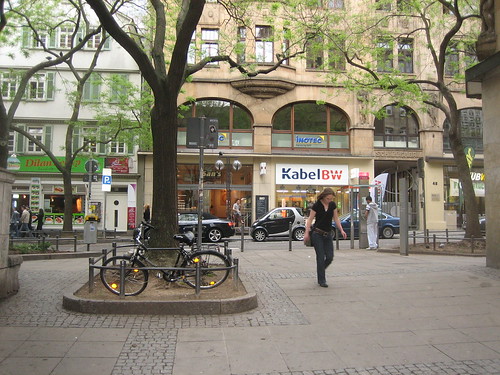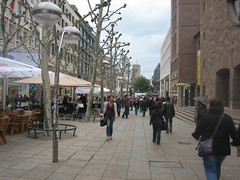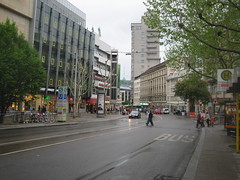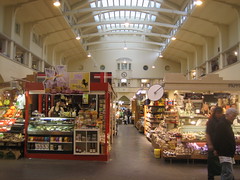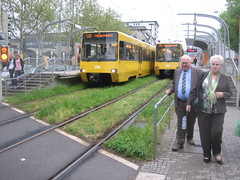Stuttgart is Germany’s sixth largest city and the capital of Baden-Württemberg in southern Germany. Besides a short stop in Frankfurt to change from a bus to a train, Stuttgart was the first place I visited in Germany and it left a pretty good first impression. I arrived there afternoon on Friday, April 30, after a day of travel via plane, bus, and train from my spring semester home in Rome. My entry was through Stuttgart’s Hauptbahnhof (main train station), located of course near the old city center and next to expansive Schloßgarten, a 600 year old palace garden now containing several cultural facilities like the State Theatre and Art Gallery. The garden is bordered on the west side by Königstraße, the” main street” of Stuttgart that is a bustling pedestrian zone dominated by retail.
Central Stuttgart has a wonderful sense of place with mostly calm, pedestrian-scaled streets and a wealth of public spaces. Despite some light rain, it was pretty active this late Friday afternoon, especially on Königstraße. The city center is a good size and nice mix of old and new. Marktplatz is a large, but intimate space tucked away in the old streets of the inner city, surrounded by mostly contemporary buildings (it was damaged heavily during WWII) including the rebuilt and recently renovated Rathaus (city hall). The general public is able to go freely inside the Rathaus where there were exhibits on city redevelopment proposals and a small art gallery on the ground floor. A block away from Marktplatz is the Markthalle, a large enclosed market building. Originally completed in 1914, it was heavily damaged in WWII and rebuilt in 1953. It is very bright and clean inside with around 50 stalls.
I mostly just walked around that evening (and checked out the Straßenbahn), but also enjoyed some live music. After having supper at a small, casual burger place I went back to a basement jazz club I had passed earlier. The “Oldtime Jazz Quintett” was playing that night at the Traditonal Jazz Hall. The place was not very busy with mostly groups of older couples (they also served German fare so I regretted not just going here for dinner). Instead I just had a German beer with my jazz. The group played several numbers I recognized including one of my favorites, “Take Five” by Dave Brubeck. It was a fun evening and good start to trip.
This was the extent of my visit to Stuttgart, but I was really impressed with what I saw. The city scale is appealing with a distinctive city center that despite modernization and reconstruction after WWII maintains its charm and sense of significance. Compared to my aesthetic perception of American cities of similar [population] sizes, Stuttgart really didn’t feel like such a large city because it lacked many of the negative aspects we usually associate with big cities in the United States – like traffic, ailing inner city neighborhoods, tall skyscrapers, and (in most cases) a physical and psychological disconnect between the urban core and surrounding areas. By maintaining its compact, human-scaled inner city (like most European cities) Stuttgart manages to accommodate the same kind of commerce, business, and industry without compromising good urban form and spaces that promote vibrancy, accessibility, and actual sense of community. The qualities of Stuttgart are things American cities aspire for, but (for most) are limited by existing urban form, political and individual will and of course the history that determined the structure and direction of urban growth and (re)development.
See all my photos from Stuttgart here. Next posts about Kandel, Munich, Berlin and more coming soon.
